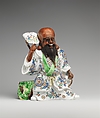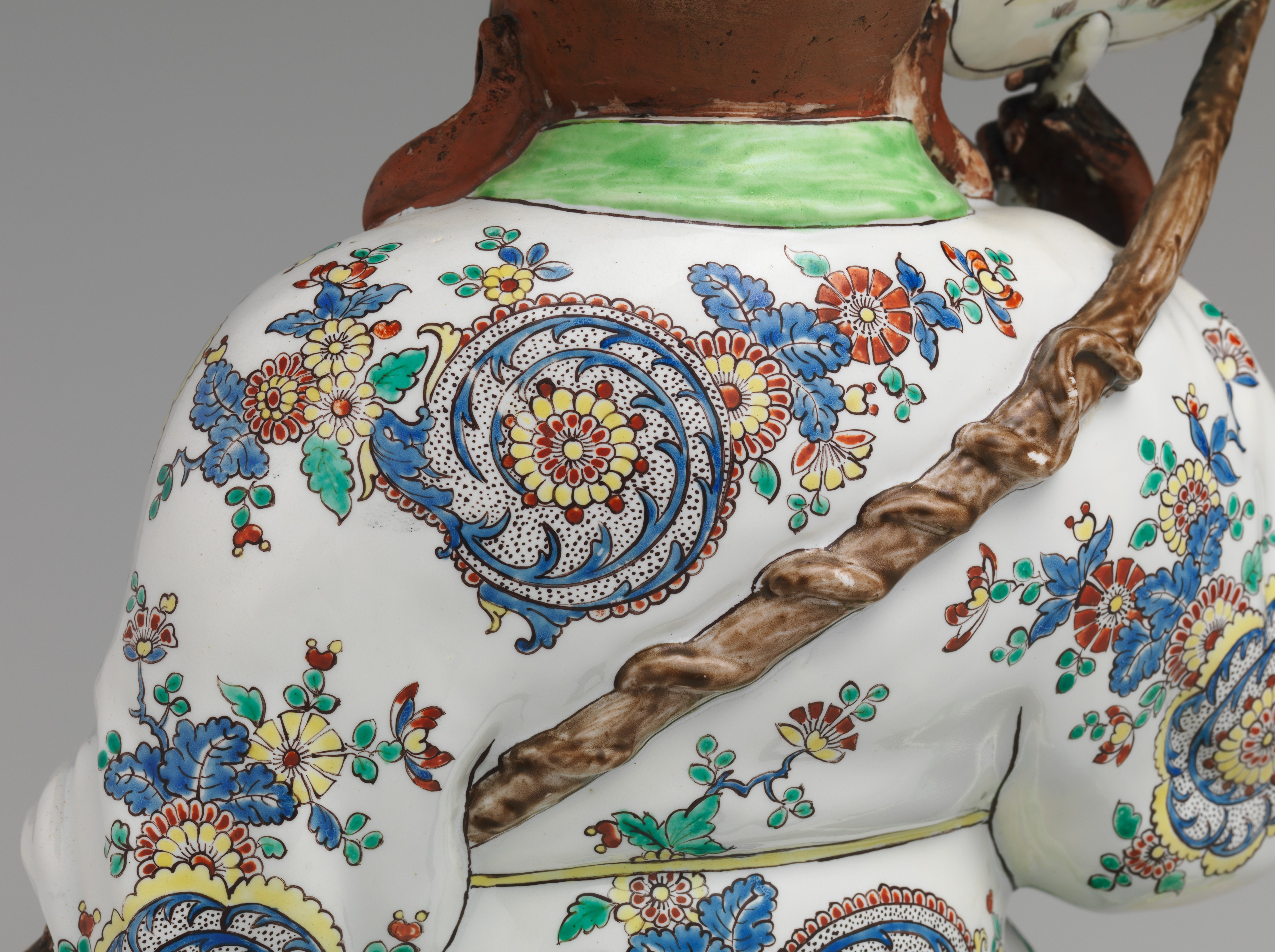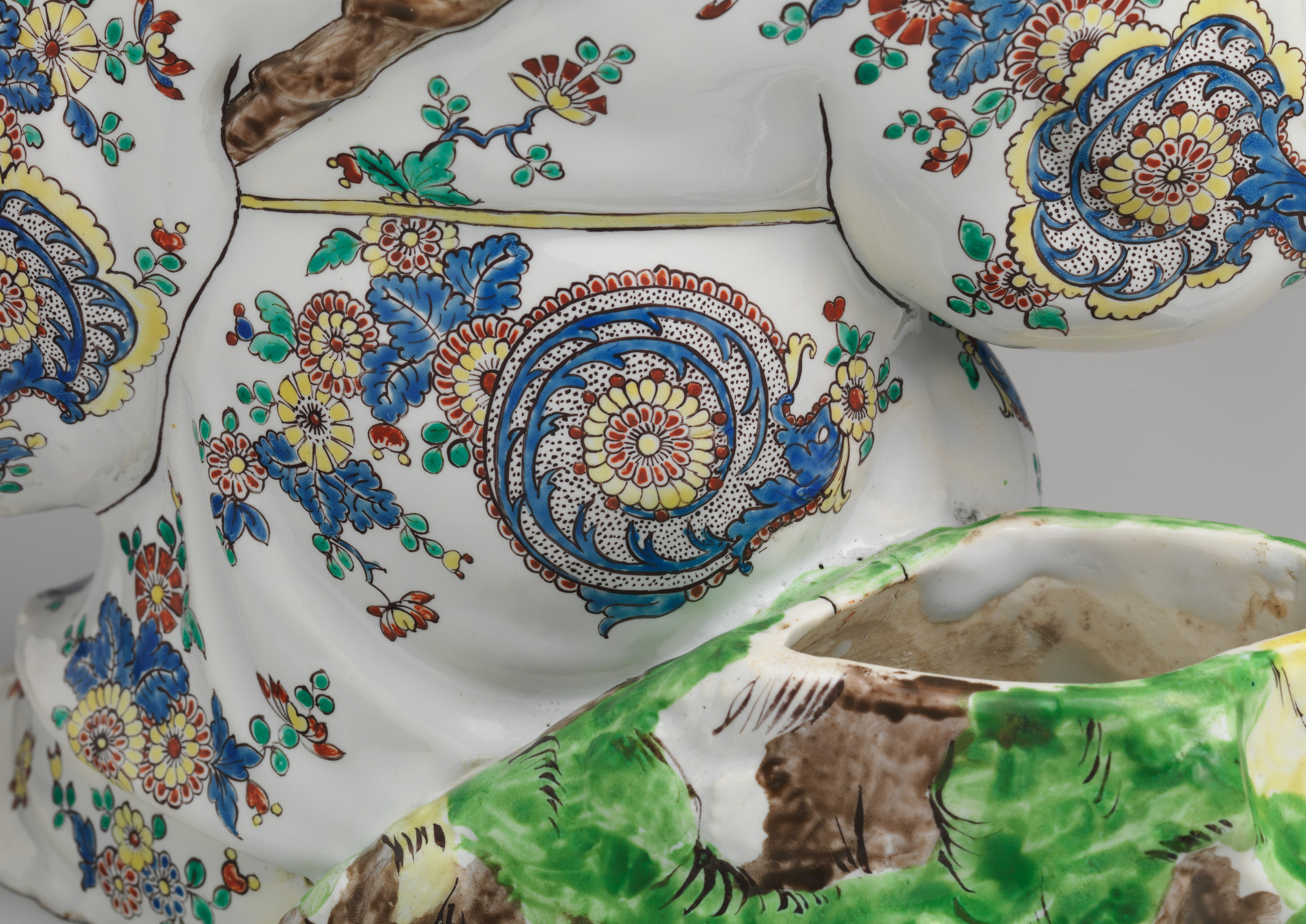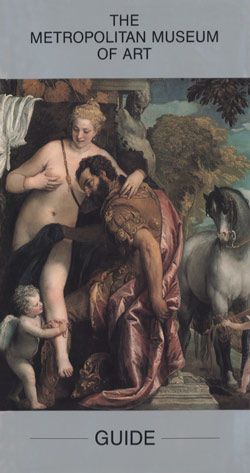Shoulao
Factory Chantilly French
This porcelain figure depicts Shoulao, the Daoist god of longevity. Along with Fuxing (god of happiness and good fortune) and Luxing (god of wealth), Shoulao was frequently portrayed in paintings and on ceramic vessels beginning with the Ming dynasty (1368–1644) in China,[1] during which time three-dimensional ceramic depictions of him began to appear as well.[2] Shoulao’s most recognizable attribute is his elongated bald cranium, which symbolizes wisdom and long life. As in this example, representations of Shoulao commonly portray him as a smiling old man, his age indicated by his long beard. The pronounced earlobes in this example are not frequently found, though precedents exist.[3] Other traditional attributes of Shoulao, including a deer, a crane, and a peach[4]—all symbolizing long life or immortality—have not been included in this portrayal, which may reflect the lack of understanding of the true identity of this religious figure on the part of the Chantilly modeler. The Chantilly Shoulao holds a fan in his right hand, and in his left, a curving staff that extends behind him across his back. While the fan does not appear to have any symbolic meaning, the staff, with its irregular shape, may depict the branch of a peach tree, a reference to the Daoist fruit of longevity.[5]
The prominent, elongated head of the Chantilly figure is accentuated by the unusual manner in which it has been decorated. Whereas the rest of the figure has been tin-glazed and decorated with enamel colors, the head and the arms have been painted with a brown pigment that has not been fired after application. A similar unfired black pigment has been used for the beard and eyebrows, and these unfired pigments have a matte surface that together distinguish them from the rest of the figure by drawing attention to the remarkable head and face. The use of a darker pigment or enamel for Shoulao’s head is not commonly found on Chinese representations of the deity, but examples decorated in this manner are known.[6]
The Chantilly factory produced a sizable number of figures during the 1730s intended to represent Asian deities or figures, and often the line between the two is considerably blurred. The visual evidence offered by these figures indicates that fidelity to an Asian model was not the goal; rather, the intent seems to have been to evoke an exotic and romanticized Far East with its unfamiliar deities and inhabitants. Some of the Chantilly figures were clearly made as representations of Budai, the laughing monk, and Fuxing.[7] Figures of Budai in glazed but undecorated porcelain from Dehua, located in the central Fujian province, and commonly known by the nineteenth-century term blanc de chine, were widely exported from China to Europe during the seventeenth and eighteenth centuries, and they served as both models and sources of inspiration for the modelers at Chantilly and other European factories.[8] However, most of the Asian-style figures produced at Chantilly were only loosely inspired by Chinese or Japanese models, if at all, and it is often unclear if a deity or generic “Asian” figure is being portrayed. This lack of clarity regarding the identity of these figures is reflected in the two terms that were used, seemingly interchangeably, to categorize this type of object. Both pagodes and magots were the catchall French terms in the eighteenth century to describe figural sculpture that evoked Asian characters.[9] The sale catalogue for the artist François Boucher’s (French, 1703–1770) collection included more than three pages of pagodes de pâtes des Indes,[10] referring to various models of these figures, many of which were partially or entirely made of brown stoneware. Of particular relevance to the Chantilly factory, the inventory of the collection of the factory’s patron, Louis-Henri (1692–1740), duc de Bourbon, seventh prince de Condé, listed more than forty pagodes in a variety of media.[11]
It is probable that several of these figures served as inspiration for the modelers at Chantilly, and the large number of such figures in Louis-Henri’s collection may account for the unusually wide array of pagode models produced by the factory. Seated figures with either globes[12] or potpourri jars[13] were especially popular, and both seated[14] and standing figures[15] with nodding heads were also produced. The sheer variety of pagodes made at Chantilly and the other French soft-paste porcelain factories at Saint-Cloud and Villeroy[16] attest to the popularity of such figures in the middle decades of the eighteenth century in France, and even Denis Diderot’s Encyclopédie (vol. 9, 1765) mentions, with considerable disdain, the fascination with which these figures were held.[17] While Chinese porcelain figures of Shoulao from earlier centuries were produced for domestic altars or shrines, as gifts, or even for burial with the deceased,[18] the Chantilly figures of Shoulao, Budai, and other Chinese personages presumably were devoid of any symbolism or particular meaning at the time of their production. One may assume that they were intended to be playful evocations of an alluring but little-understood culture, and their decorative function is underlined by the fact that many may have been produced to be mounted in gilt bronze to form clocks or candelabra.[19] The open tublike container that sits behind Shoulao to the left may have served a function that was connected to a now-disappeared gilt-bronze mount. A similar opening appears on a figure of Shoulao most closely related to the Museum’s example. This figure, now in the Musée des Arts Décoratifs, Paris,[20] sits rather than stands, and his beard and eyebrows have not been picked out in black enamel. However, his head is also painted with unfired brown pigment, and his robe is decorated with very similar and distinctive spiraling motifs centered by a blossom and Japanese Kakiemon-style flowers. The placement of the open container to this figure’s right might suggest that the New York and Paris figures were made as a pair, intended to be mounted in gilt bronze and to serve as fashionable objets de luxe, enhanced with touches of playful exoticism.
Footnotes
(For key to shortened references see bibliography in Munger, European Porcelain in the Metropolitan Museum of Art. NY: The Metropolitan Museum of Art, 2018)
1 Matos 2011, vol. 1, p. 232.
2 Ströber 2011, pp. 154–55, no. 57.
3 Matos 2011, vol. 1, pp. 232–33, no. 93.
4 See Ayers 2002, p. 94, no. 45.
5 Alternatively, it may depict a ruyi scepter, a symbol of good fortune.
6 Harrison-Hall 2001, p. 442, no. 14:14.
7 For examples, see Clare Le Corbeiller in Roth and Le Corbeiller 2000, pp. 40–41, no. 17; William Rieder in Metropolitan Museum 1984a, pp. 240–41, no. 148.
8 Le Corbeiller in Roth and Le Corbeiller 2000, p. 41.
9 Ibid., p. 41, n. 5; Kisluk-Grosheide 2002.
10 Catalogue raisonné des tableaux . . . M. Boucher 1771, pp. 89–93.
11 Le Corbeiller in Roth and Le Corbeiller 2000, p. 41.
12 Le Corbeiller 2003.
13 Le Corbeiller in Metropolitan Museum 1984a, p. 324, no. 301.
14 Jeffrey H. Munger in Munger et al. 1992, pp. 218–19, no. 171.
15 Morley-Fletcher 1993, vol. 2, pp. 56–57.
16 Le Corbeiller in Metropolitan Museum 1984a, pp. 318–19, nos. 290, 291.
17 Diderot 1969, vol. 2, p. 734, s.v., “magot.”
18 Matos 2011, vol. 1, p. 232.
19 For example, see Le Duc 1996, ill. pp. 161, 164, 165. The latter two are in the Museum (1974.28.91; 1982.60.84).
20 Musée des Arts Décoratifs, Paris (GR 299).
Due to rights restrictions, this image cannot be enlarged, viewed at full screen, or downloaded.
This artwork is meant to be viewed from right to left. Scroll left to view more.








